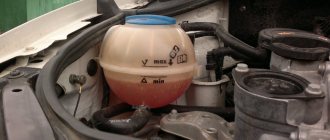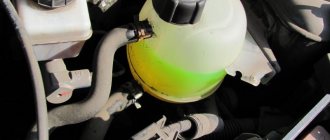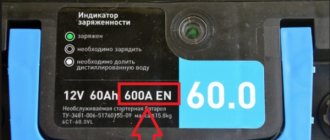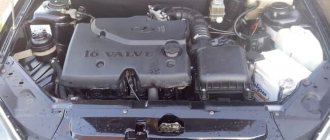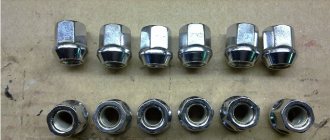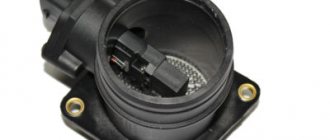The operating principle of a car battery is no different from other types of autonomous power sources. The component that ensures the chemical reaction is the electrolyte, thanks to which the battery is charged and discharged. To maintain the vehicle's performance, the driver must control the level and density of the process fluid, which will extend the life of the battery, maintain the capacity in amperes, and ensure reliable engine starting at subzero temperatures.
It is important to monitor the level and density of the electrolyte in the battery to extend its service life.
Why is electrolyte needed in a battery?
Lead-acid batteries undergo electrochemical processes that produce electricity. These processes are possible only with the direct participation of the electrolyte.
The battery has negatively and positively charged plates. They contain lead conductive elements. They may have various additives, which determine the type of battery.
The degree of charge of the battery depends on the density of the electrolyte. If it is increased, the battery will be overcharged, and an aggressive environment can generally harm the battery. When it is lowered, the battery will be discharged. The density of concentrated battery acid is 1.835. In order to bring the value to normal, it is necessary to use distilled water.
The range of indicators for a normally charged battery is within 1.23 – 1.25 g/cm3. When the engine starts, the audio and light elements are turned on, the battery discharges. This happens due to the occurrence of an electrochemical reaction. The substance loses sulfuric acid, resulting in a drop in density and discharge of the battery.
Let's sum it up
Taking into account the above information, it becomes clear that the electrolyte level in a car battery must be monitored and maintained during operation. This means that if the battery is serviceable, there is the possibility of both checking and adjustment. To do this, you should learn in advance how to check the electrolyte in the battery.
We also recommend reading the article on how to increase the density of the electrolyte in a car battery. From this article you will learn why it is important to maintain the required battery density, as well as how to increase or decrease the density of the battery solution.
In fact, following the above instructions, any car owner can check the electrolyte level in the battery in a regular garage. It will also not be difficult to increase the electrolyte level in the battery “banks” if necessary. The main thing is to take into account all the nuances discussed above, as well as follow all safety rules and recommendations when servicing a car battery.
How much electrolyte should be in the battery
The car owner must constantly monitor the electrolyte level. If it drops, you will need to add distilled water. Depending on the battery capacity, the volume of the mixture will depend:
- 55 Ah – 2.5 l;
- 60 Ah – 2.7-3 l;
- 62 Ah – about 3 l;
- 65 Ah – about 3.5 l;
- 75 Ah – 3.7-4 l;
- 90 Ah – 4.4-4.8 l;
- 190 Ah – about 10 liters.
Depending on the manufacturer, technology and model, these figures may vary, so they are conditional. The main thing to remember is that the electrolyte must completely cover the plates by 10-15 mm and in no case should they protrude.
Battery cover sensor
AKOM has confirmed the ISO 16949 certificate.
From June 9 to 11, an inspection audit was carried out to confirm the compliance of the quality management system with the requirements of the ISO TS 16949 - 2002 standard READ MORE
To avoid misunderstandings, we ask you to carefully study the operating instructions, and also check that the warranty card is complete and correct. Require filling in the details regarding the condition of the battery with the stamp of the trading organization. Otherwise, the warranty card is considered invalid!
The guarantee is valid only upon presentation of a sales or cash receipt.
If you have a correctly completed warranty card from the TRADE AND SERVICE CENTER
You are entitled to discounted battery service.
USER MANUAL
1.1
Lead-acid starter battery (AB), rated voltage 12 V, maintenance-free, filled with electrolyte and charged, manufactured in accordance with the requirements of GOST 959 and TU 3481 -001-57586209-2002 During the manufacture of the battery, it is filled with a solution of premium sulfuric battery acid in accordance with GOST 667 and demineralized water.
1.2
The battery does not require maintenance* during the warranty period due to low water consumption, i.e. Adjustment of the electrolyte level is not required if the conditions of Section 4 “Operation and Care of the Battery” are met.
*The battery belongs to the maintenance-free category, as it meets the requirements of clause 2.2.10 of GOST 959.
2. PREPARING THE BATTERY FOR OPERATION
2.1
Check the battery by external inspection for the absence of mechanical damage, cracks, chips, leaks on the case and on the pole terminals.
2.2
Check the voltage at the pole terminals. When the voltage is less than 12.5 V. The battery must be charged. Charging should begin with a current of no more than 5% of the rated capacity for two hours, followed by an increase in the charging current to 10% of the rated capacity. For example, for a battery with a nominal capacity of 55Ah, the charging current is 2.75A and 5.5A, respectively. A sign of the end of charging to 0.4A and its stabilization within one hour at a charging voltage of 14.4V.
ATTENTION! Explosive gas is released during charging!
The room where charging is carried out must be ventilated; smoking and the use of open flames are prohibited.
2.3
Check the density and level of the electrolyte. The electrolyte density should be 1.27+-0.01 g/cm3 at +25˚С. At a temperature other than +25˚С, the value of the measured density is reduced to the density of the electrolyte at +25˚С by calculation using formula (1) p. 4.6. If the electrolyte density is below 1.25 g/cm3 at +25˚C, the battery must be charged according to clause 2.2. The electrolyte level above the upper edge of the plates should be within 25-35 mm. * clauses 2.1, 2.2, 2.3 are carried out by the trading organization (see text).
3. MOUNTING AND CONNECTING THE BATTERY
3.1
Attach the battery to the vehicle according to its owner's manual. Unreliable fastening of the battery can lead to a short circuit, mechanical damage, destruction of the pole terminals, loss of tightness, leakage of electrolyte and, as a result, corrosion of the body.
3.2
Before connecting, clean the contact areas of the battery pole terminals and wires.
3.3
Connecting and disconnecting the battery when consumers are de-energized. The ignition switch must be in the “Off”, “O” position (or “Lock” on foreign cars). Consumers connected directly, i.e. dimensions, heated seats, radio, etc. must be de-energized. The “+” pole terminal is connected first, then the “-” pole terminal. Disconnecting the power wires is done in the reverse order.
4. OPERATION AND CARE OF BATTERY
4.1
Before starting the engine after a long period of parking at subzero temperatures, warm up the battery electrolyte by briefly (3-4 seconds) turning on the high beam headlights two or three times.
4.2
When starting the engine, do not load the battery for more than 5 seconds. For one attempt, the break between attempts must be at least one minute. If after five attempts the engine does not start, you should check the functionality of the fuel supply and ignition system. Repeated, long-term startup attempts lead to deep discharge of the battery, a drop in electrolyte density, destruction and sulfation of the plates and, as a result, a sharp decrease in service life.
4.3
Make sure your vehicle's electrical wiring is in good condition. Leaks in the circuits lead to battery discharge.
4.4
Keep the battery clean, especially in the terminal area. Wipe periodically with a rag soaked in a 10% solution of ammonia or soda ash.
4.5
To protect the pole terminals from oxidation and maintain contact in the area of the pole terminals and maintain contact in the area of the current-collecting tips of the wires, apply a preservation compound after their installation.
4.6
Operating a discharged battery at sub-zero temperatures can lead to freezing of the electrolyte and destruction of the battery. To determine the freezing point of the electrolyte, it is necessary to bring its measured density to the density at +25˚С, using the formula:
P +25-C = rm + (Tizm - 25˚C) ×0.0007(1) where P+25T is the density of the electrolyte at +25˚C;
rism – measured electrolyte density;
Tism is the measured temperature of the electrolyte.
Example: the measured density of the electrolyte was 1.2 g/cm3, the measured temperature of the electrolyte was minus 10C, substituting it into the formula, we get:
Р+25-с =1.2g/cm3 +[(-10˚С)-25˚С]×0.0007
According to the table, we find that an electrolyte with such a density will freeze at a temperature of minus 22˚C.
4.7
Periodically check the battery charging system, the voltage at the pole terminals of which at crankshaft speeds of 1500-2000 rpm and high beams on should be within 14.1 ± 0.3 V. Long-term overcharging at a voltage of 14.5V and above leads to corrosion of the positive plate grids, decomposition of water in the electrolyte and a decrease in its level until the upper edges of the plates are exposed. Long-term undercharging, at a voltage of 13.7V and below, leads to a decrease in the degree of charge of the battery and the density of the electrolyte and its freezing in winter (clause 4.6). Overcharging and undercharging the battery accelerates wear and tear even during the warranty period.
4.8
The discharge of the battery during long-term parking and subsequent disruption of its performance is caused by faulty electrical wiring with high leakage currents, an alarm system or powerful additionally installed equipment that consumes energy exceeding the capabilities of the battery's energy capacity and the power of the energy supply system.
How to check the electrolyte level in a battery
Most batteries on the banks have a scale with MIN and MAX values, and it is in this range that the electrolyte should be. There are models with plastic tabs under the stoppers that go down inside the cans; they should be immersed in the liquid by 5 mm.
Modern batteries are equipped with a special sensor on the case, which indicates a low electrolyte level and the degree of discharge of the battery.
If for some reason there are no symbols, then you can resort to the following method:
- Take a small, clean tube;
- Wipe the battery case clean and dry;
- Unscrew the lids from all the cans;
- We lower the tube into the jar at a right angle and touch its plates;
- Press the top hole of the tube tightly with your finger;
- Carefully pull out and measure the height of the liquid (should be at the level of 10-15 mm);
- We repeat the procedure with all banks.
If there is not enough mixture in the jars, you will need to add distilled water. You need to top up until the plates are completely closed. Distilled water can be purchased at a pharmacy. You cannot use regular tap water.
If you operate a car with “bare plates,” they will quickly crumble and fall apart.
There are now maintenance-free batteries on the market. If there are no lids on the body, then you will not be able to add water into it.
Technical characteristics of the model range
The Akom model range includes batteries of different capacities, starting currents, and different polarities. You can choose a model for both European and Asian cars, both passenger cars and trucks. The full range and characteristics of each line can be found on the official website.
Akom
This launch series includes models for European and Asian passenger cars (Asia), as well as for trucks. The passenger group includes batteries with a capacity of 55 to 100 Ah, cold cranking current from 460 to 870 A. Trucks have a capacity of 140 - 190 Ah, with starting currents of 950 and 1200 A. For Asian cars, batteries with a capacity of 40 to 100 Ah are intended, with cold cranking current from 330 to 790 A.
Akom
| Akom | Capacity | Starting current | Dimensions | Weight |
| European cars | 55 | 460 | 242x175x190 | 14,8 |
| 55 | 520 | 242x175x175 | 15,5 | |
| 60 | 520 | 242x175x190 | 15,5 | |
| 60 | 590 | 242x175x175 | 15,8 | |
| 62 | 540 | 242x175x190 | 16 | |
| 65 | 580 | 242x175x190 | 16,5 | |
| 74 | 700 | 277x175x175 | 18,5 | |
| 75 | 700 | 277x175x195 | 18,5 | |
| 90 | 780 | 353x175x190 | 23,5 | |
| 90 | 870 | 353x175x175 | 23 | |
| 100 | 850 | 353x175x190 | 24,5 | |
| Asian cars | 40 | 330 | 187x127x225 | 9,8 |
| 50 | 420 | 238x129x225 | 12,7 | |
| 65 | 520 | 232x173x225 | 16,1 | |
| 75 | 600 | 260x173x225 | 18,3 | |
| 100 | 700 | 305x173x225 | 21,9 | |
| Trucks | 140 | 950 | 513x189x215 | 40 |
| 190 | 1200 | 513x189x215 | 50 |
Akom EFB
Batteries in this series are new from the manufacturer Akom. They are created using advanced EFB technology and meet all international quality standards. An improved separator and a new plate design almost doubles the service life of the structure. The starting current has also been increased.
The batteries work in all weather conditions. They perfectly withstand the range from -40 to +50 degrees Celsius. They have a double resource. Compared to conventional batteries, they can withstand twice as many full charge-discharge cycles and are not afraid of deep discharge and are resistant to corrosion.
Suitable for modern premium vehicles equipped with a start-stop system and a large amount of electronics.
The batteries presented in this line have capacities from 55 to 100 Ah and cold cranking current from 530 to 930 A.
Akom EFB
| Akom EFB | Capacity | Starting current | Dimensions | Weight |
| Vehicles with Start-Stop system | 55 | 530 | 242x175x190 | 16,2 |
| 60 | 560 | 242x175x190 | 16,6 | |
| 62 | 580 | 242x175x190 | 16,6 | |
| 65 | 650 | 242x175x190 | 18,1 | |
| 75 | 720 | 275x175x190 | 19,8 | |
| 90 | 820 | 353x175x190 | 24,3 | |
| 100 | 930 | 353x175x190 | 25 |
Akom Reactor
Reactor batteries are powerful and have higher inrush currents. Designed for cars literally “studded” with various energy consumers. According to the manufacturer, they have no analogues in Russia.
Capacities range from 55 to 100 Ah, and cold cranking current from 550 to 1000 A.
Akom Reactor
| Akom Reactor | Capacity | Starting current | Dimensions | Weight |
| Cars | 55 | 550 | 242x175x190 | 15 |
| 62 | 620 | 242x175x190 | 16,8 | |
| 75 | 750 | 278x175x190 | 20 | |
| 100 | 1000 | 353x175x190 | 26 |
Akom Ultimatum
Ultimatum batteries are aimed at vehicles with a start-stop system and a large number of energy consumers. Akom Ultimatum is also used on boats, yachts and motorhomes. One of the obvious advantages is resistance to deep discharges.
The capacity of the models presented in the line ranges from 60 to 95 Ah. Starting current – from 550 to 850 A.
Akom Ultimatum
| Akom Ultimatum | Capacity | Starting current | Dimensions | Weight |
| EFB battery for cars with a start-stop system, and the same for boats, yachts and motorhomes | 60 | 550 | 242x175x190 | 16,8 |
| 70 | 640 | 278x175x190 | 19,3 | |
| 95 | 850 | 353x175x190 | 25 |
Akom Bravo
Bravo batteries have an optimal ratio of capacity and starting current. Focused on domestic and foreign vehicles with the usual set of options. Available in direct and reverse polarity. Models for cars and trucks are presented.
Tanks for cars - from 55 to 100 Ah, for trucks - 140 and 190 Ah. Cold cranking currents for the first group are from 430 to 760 A, for the second - 890 and 1100 A.
Akom Bravo
| Akom Bravo | Capacity | Starting current | Dimensions | Weight |
| Cars | 55 | 430 | 242x175x190 | 14,3 |
| 60 | 480 | 242x175x190 | 15 | |
| 74 | 650 | 278x175x190 | 18,2 | |
| 90 | 760 | 353x175x190 | 22 | |
| Trucks | 140 | 890 | 511x183x239 | 38 |
| 190 | 1100 | 524x239x223 | 46 |
What can you add water or electrolyte to the battery?
If the battery plates are not closed, it means that the level of the substance is not high enough and you need to add distilled water. At the same time, you cannot fill in plain water, since it contains various impurities that can disrupt the operation of the battery and cause it to fail.
If the mixture has sufficient density, then distilled water is added. If the density of the electrolyte approaches the lower mark, then you can add an alkaline mixture. When current passes through the battery, acid is consumed. The process is called diffusion of H2SO4 between the volume and the electrode. This maintains voltage at the battery terminals.
Checking with a load fork
A load plug is a device that represents some kind of electrical load (usually a high-resistance resistor or a refractory coil) with two wires and terminals for connecting the device to the battery, as well as a voltmeter for taking voltage readings.
The verification process is quite simple. It consists of the following steps:
- You need to work at a temperature of +20°С…+25°С (in extreme cases up to +15°С). You cannot test a cold battery , as you risk significantly discharging it.
- The plug is connected to the battery terminals - the red wire is to the positive terminal, and the black wire is to the negative terminal.
- Using the device, a load with a current of 100...200 Amperes is created (this is an imitation of a switched on starter ).
- The load acts on the battery for 5...6 seconds.
Based on the readings of the ammeter and voltmeter, we can talk about the condition of the battery.
| Voltmeter readings, V | Charge percentage, % |
| >10,2 | 100 |
| 9,6 | 75 |
| 9 | 50 |
| 8,4 | 25 |
| <7,8 | 0 |
On a fully charged battery, after applying a load, the voltage should not drop below 10.2 V. If the battery is slightly discharged, then a drop of up to 9 V is allowed (however, in this case it must be charged). And after this, the voltage should be restored almost immediately , and after a few seconds completely.
Sometimes it happens that if the voltage is not restored, then there is a high probability of one of the banks shorting. For example, with minimal load it is necessary for the voltage to recover to 12.4 V (up to 12 V is allowed with a slightly discharged battery). Accordingly, the lower the voltage drops from 10.2 V, the worse the condition of the battery. With this device you can check the battery both upon purchase and already installed in the car, without removing it.
What to do if your electrolyte level is low
If the electrolyte level drops, it will need to be topped up. First you need to fill it with distilled water and put the battery on charge. If the density does not begin to increase, you can try draining all the liquid and completely replacing the electrolyte.
Sometimes the battery is discharged to such an extent that adding new mixture may not be practical. If the element did not last long, then this procedure can be done. But this doesn't always work on old batteries. They become unusable if operated on an electrolyte with a low alkaline level.
Still have questions about your electrolyte level or have something to add? Then write to us about it in the comments, this will make the material more useful, complete and accurate.
Reviews
Sergey Excellent Russian battery. Pleasantly surprised by him. It is very reliable in operation. At the same time, every winter I wait for it to die, but it continues to work!
Mikhail I like this battery for its high starting current, reliability, and good performance in cold weather. However, he does not tolerate discharge. None at all, not to mention deep. Therefore, you need to carefully monitor.
Nikita I have a budget foreign car. Recently the question arose about replacing the battery. A familiar owner of the same typewriter suggested Akom to me. The first impression of it was the best; we survived the winter without any problems. Let's see what happens next.
